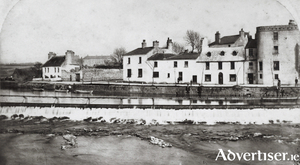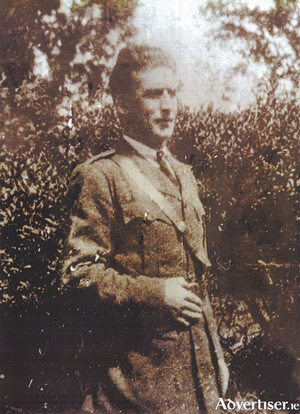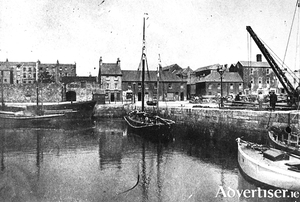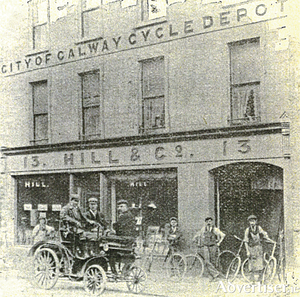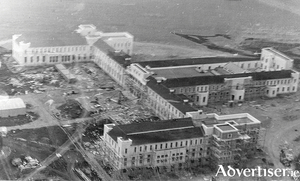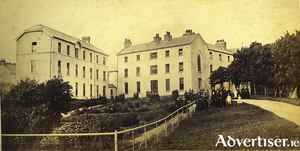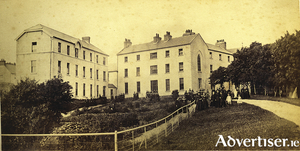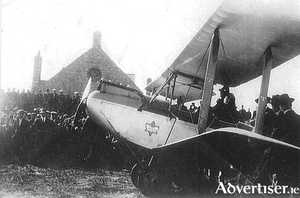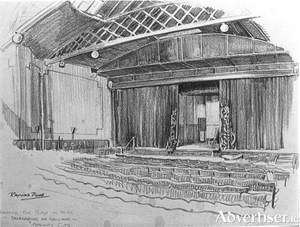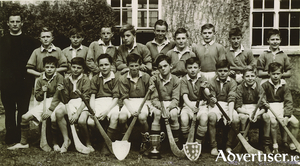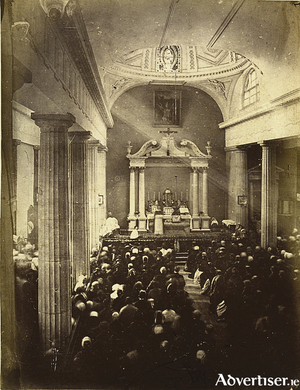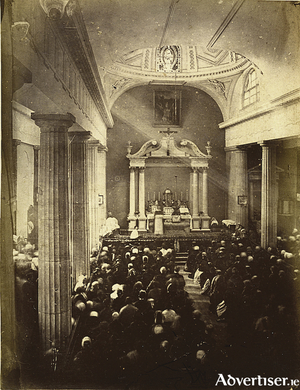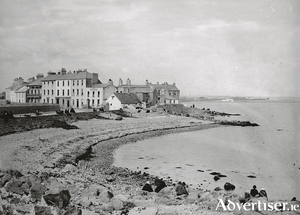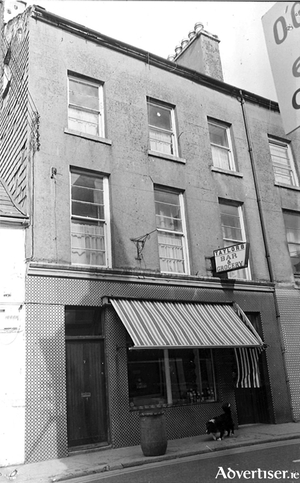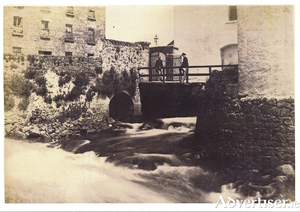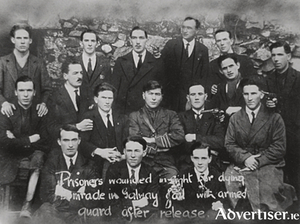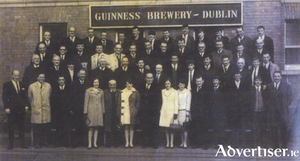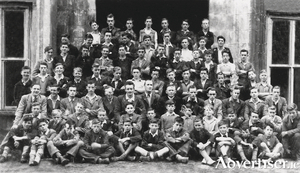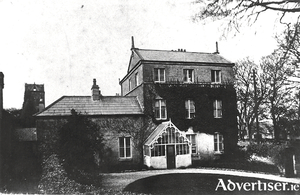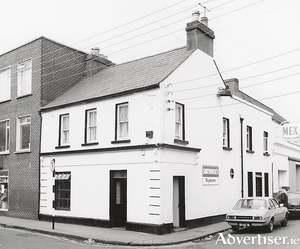Waterside, c1885
Thu, Oct 11, 2018
Some 100 years before this photograph was taken, most of the area we are looking at would have been under water, the river covered much of what is Woodquay today. Most of the people who lived in the area would have been small farmers or fishermen, their houses (outside the city walls) made of blocks of stone, often with moss stuffed into the crevices and a roof covered partly with straw, partly with turf. The river provided a rich source of food, though in the city, the fishery, from the Salmon Weir to the sea, was privately owned.
Read more ...Patrick O’Brien - volunteer
Thu, Oct 04, 2018
Patrick O’Brien was born in Waterdale, Claregalway in 1895. He joined the volunteers in 1914 and did drilling and training in arms for active operations.
Read more ...New Docks Road, c1900
Thu, Sep 27, 2018
This photograph was taken from the far side of the docks c1900 and shows New Docks Road in the distance and Bonham Quay on the right.
Read more ...Hill’s of Lower Dominick Street
Wed, Sep 19, 2018
This photograph, dated 1905, was part of an advertisement for Hill & Co Cycle Makers and for Hill’s Dublin Studio, a photographic gallery. Both of these were located in this building in Lower Dominick Street. You have to hand it to Edmund Hill, he was a dab hand at publicity, and advertised extensively.
Read more ...Coláiste Éinde, ninety years
Thu, Sep 13, 2018
Coláiste Éinde was founded very shortly after the State itself was founded. The aim was to educate boys through the medium of Irish so that they would go on to St Patrick’s teacher training college, get secure employment for life, and in turn, teach a new generation of boys through Irish. It started life in Furbo House, an old house belonging to the Blake family. A domestic problem arose within the family who owned the house, so the school’s stay there was brief and they had to leave at Christmas 1930. The college was transferred to Talbot House in Talbot Street, Dublin, the following month.
Read more ...Taylor’s Hill school, one hundred and sixty years
Thu, Sep 06, 2018
One hundred and sixty years ago on Saturday, September 8, 1858, the Dominican sisters opened their school on Taylor’s Hill. Three years before that, they had taken over a house there known as Seaview (sometimes known as Mount Eaton), which belonged to the Sloper family; a simple country house with eight rooms, a medley of kitchen premises to the rear, stables behind the house, and with it, five acres of land.
Read more ...Taylor’s Hill school, one hundred and sixty years
Wed, Sep 05, 2018
One hundred and sixty years ago on Saturday, September 8, 1858, the Dominican sisters opened their school on Taylor’s Hill. Three years before that, they had taken over a house there known as Seaview (sometimes known as Mount Eaton), which belonged to the Sloper family; a simple country house with eight rooms, a medley of kitchen premises to the rear, stables behind the house, and with it, five acres of land.
Read more ...Lady Mary Heath in ‘The Swamp’
Thu, Aug 30, 2018
Lady Mary Heath was a famous pioneering pilot. She was born in Knockaderry near Newcastle West, Co Limerick, in 1896. She was an accomplished sportswoman who helped introduce women’s track events to the Olympics. The 1920s was an era when the world seemed to have gone aviation mad, thanks to the exploits of Charles Lindbergh and Amelia Earhart. In 1927, Lady Mary became the first woman to hold a commercial licence in Britain, the first woman to parachute out of an aircraft, and the first pilot to fly a small open-cockpit plane from Cape Town to London. She set records for altitude in a small plane. For much of the 1920s she was one of the best known women in the world, brave, determined, and accomplished.
Read more ...An Taibhdhearc, ninety years a’growing
Thu, Aug 23, 2018
On December 3, 1927, a group of people met with the idea of setting up an Irish language theatre in Galway. The committee elected were Dr Séamus Ó Beirn, president; Seán Mac Giollarnáith, treasurer; Liam Ó Briain and Séamus Luibhéid, secretaries; An tAthair Pádraic Ó hEidhin, Liam Ó Buachalla, Síle Ní Chinnéide, Tomás Ó Raghallaigh, Mícheál Ó Droighneáin, Donal Ó Riordáin, and Tomás Ó Máille.
Read more ...The art of hurling
Thu, Aug 16, 2018
In the year 1527, it was decreed in one of the Galway Statutes that “At no time to use ne occupy ye hurling of ye little balle with the hookie sticks or staves, nor use no hand balle to play without the walls, but only the great foot balle”. It seems the authorities of the day were trying to limit the playing of hurling, but they might as well have tried to hold back the tide.
Read more ...The Abbey Church
Thu, Aug 09, 2018
In the year 1296, Uilliam Liath De Burgo started to build a monastery for the Franciscans on a site roughly where the Courthouse is today. It became known as “St Francis’ Abbey on the island of Saint Stephen on the north side of the town”. The island was formed by the river on the west side, and by a branch of the river running through what is Woodquay and Mary Street today, to join the main stream above O’Brien’s Bridge. A second and smaller island lay between St Stephen’s and the town wall, so in order to communicate with the town, two bridges were necessary, one at the junction of Mary Street and Abbeygate Street and the other at the Little Gate.
Read more ...The Abbey Church
Wed, Aug 08, 2018
In the year 1296, Uilliam Liath De Burgo started to build a monastery for the Franciscans on a site roughly where the Courthouse is today. It became known as “St Francis’ Abbey on the island of Saint Stephen on the north side of the town”. The island was formed by the river on the west side, and by a branch of the river running through what is Woodquay and Mary Street today, to join the main stream above O’Brien’s Bridge. A second and smaller island lay between St Stephen’s and the town wall, so in order to communicate with the town, two bridges were necessary, one at the junction of Mary Street and Abbeygate Street and the other at the Little Gate.
Read more ...Seapoint Corner about one hundred and fifty years ago
Thu, Aug 02, 2018
This was Seapoint Corner c1865. The buildings we see, running from the left, are Prospect Lodge; Corrig View; Elm View; Prairie House with the balcony, which was built 1855-1861 by Colman O’Donohoe who had obviously spent some time in America; Beachmount; Villa Marina, which had the sign Michael Horan, Grocer over the door; Sunnyside Lodge; Seapoint House; then a gap which led into Seapoint Terrace; and finally, the thatched building which was George Fallon’s Baths. The sign on his gable read Hot Baths and Bathing, No Refunds and his family operated the baths business at least from 1855 to 1894
Read more ...Taylor’s Bar
Thu, Jul 26, 2018
This late 19th century building in Upper Dominick Street was originally a grocery and a pub owned by a family of O’Connells. They used to stable horses out the back. When they sold it, they moved to Dublin where one of them was unfortunately murdered. The pub was taken over by a Mr Cosgrave.
Read more ...Persse’s Distillery
Wed, Jul 18, 2018
For much of the 19th century, the Persse family ran one of the most successful distilleries in Ireland. Their product became world famous. They were major contributors to the industrial life of Galway and provided much needed employment. In addition to their staff, they were also supplied by a number of artisans working in the Nuns Island area — coopers, cork manufacturers, printers, carters, case makers, etc.
Read more ...Fire and protest in Galway Jail
Thu, Jul 12, 2018
Diarmuid Crowley, a native of Co Cork, was arrested, charged with being a judge in the Sinn Féin courts, and incarcerated in Galway Jail even though he was ill. His condition worsened and he demanded the attendance of a private medical doctor. The prison doctor refused, so 40 Sinn Féin prisoners decided to do something to prevent Mr Crowley suffering any further.
Read more ...The Connacht Mineral Water Company
Thu, Jul 05, 2018
The Connacht Mineral Water Company was incorporated 80 years ago tomorrow, on July 6 1938. The first board meeting was held on July 18 and the following were appointed as directors: John Keane, chairman; John E Cotter, vice-chairman; and Paul O’Dea, secretary and managing director.
Read more ...Our Lady’s Boys’ Club camp
Thu, Jun 28, 2018
When President Michael D Higgins, officially opened the new Our Lady’s Boys’ Club clubhouse in 2015, he said: “Like so many successful community initiatives, OLBC was founded and built on vision, a spirit of participation and a will to make a genuine and positive difference to the community. When Fr Leonard Shiel SJ established a club in 1940, I doubt that he realised just how enduring his vision would be. Today, OLBC is the longest running youth club in the country and has woven its way into the fabric of community life in Galway, welcoming members from many neighbourhoods including Shantalla, Westside, Ballinfoyle, Rahoon, Corrib Park, and Newcastle.
Read more ...Spires House, Shantalla
Thu, Jun 21, 2018
In 1924, three Sisters of Jesus and Mary came to UCG to study for a degree, the first religious of any congregation to do so. While they were pursuing their studies, Mother Stanislaus looked for a suitable premises for a house of studies and finally purchased “Spires House” in Shantalla on June 26, 1925. The house apparently got its name from the two unusual spires you can see on the roof. It was used by the sisters as a hostel for secular students as well as their own nuns. These nuns were known to many people as ‘The Spires Nuns’.
Read more ...The Crane Bar
Thu, Jun 14, 2018
This pub, which is situated on the corner of William Street West and the Small Crane, was originally known as the West End Bar. In the 1930s it was owned by Paddy and Angela (known as Alda) Smith who lived over the pub. They also owned the garage behind the pub, which Paddy managed. This was where Bell, Book and Candle bookshop is today. Mrs Smith was from Loughrea and when she and her husband retired, they sold the business to her brother Mickey Coen. He ran it until 1970 when Padraig Cummins took it over. Padraig had a business in Menlo making concrete slabs.
Read more ...